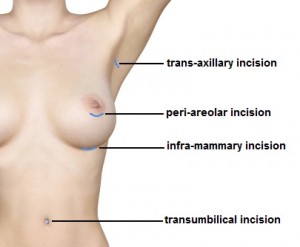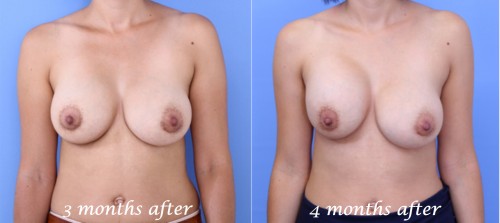 New data presented at the 2013 American Society for Plastic Surgeons (ASPS) meeting suggests that your choice of incision does affect your risk of capsular contracture.
New data presented at the 2013 American Society for Plastic Surgeons (ASPS) meeting suggests that your choice of incision does affect your risk of capsular contracture.
The overall risk of capsular contracture after breast augmentation surgery is a range of about 15-20%, but new data suggests that the risk can be decreased to approximately 5% with inframammary incisions (in the fold under the breast). The two other most common incisions for breast augmentation are the periareolar incision (around the bottom half of the areola) and the transaxillary incision (through the armpit). This new research suggests that you have a significantly reduced risk of capsular contrature by choosing an inframammary incision for your breast augmentation procedure.
Keep reading to learn more about incisions for breast augmentation surgery and capsular contracture…
Capsular contracture is a hardening and tightening of the scar tissue capsule that surrounds breast implants. This capsule is normally a soft, supple structure that acts like an internal bra to support your implants from the inside. A capsule is a completely normal part of any implant procedure, not just breast implants, but it can become very abnormal in cases where capsular contracture develops.
Capsular contracture may develop as soon as 3-4 months after surgery, and can progress very quickly or very slowly. It can also develop much longer after surgery, even years after, and this delayed presentation is usually associated with some form of trauma to the implant or with an implant rupture, particularly if the implant is older than 10-15 years.
This is a photo series of a breast augmentation patient who had a near-perfect result at 3 months after having silicone breast implants placed through a periareolar incision. The photo on the left was taken at 3 months after surgery, and the photo on the right at 4 months. You can see that her right breast implant shifted upwards and took on a more rectangular shape because the implant capsule began squeezing and distorting it. She did experienced a mildly uncomfortable tightness on that side, and ended up needing a revisional procedure to remove the contracted capsule.

The following list of options lead to the lowest possible risk of capsular contracture:
- An inframammary incision. It has been common knowledge for quite a while that the transumbilical and transaxillary incisions should not be used because only saline implants can be inserted through these incisions, and saline implants have a higher risk of contracture to begin with. However, the newest research suggests that even the periareolar incision carries a higher risk of contracture as compared to the inframammary, and this has not been known until recently.
- A silicone implant. Current generation of silicone implants are better than saline in every way, but most importantly, they have a lower risk of contracture compared with saline.
- A sub muscular pocket. Placing the implant under the muscle appears to lower the risk of capsular contracture slightly, but this statistic isn’t conclusive across all studies.
- A smooth postoperative recovery period. Almost any postoperative complication such as hematomas, seromas, infections, and the need for early revisional procedures increase the risk of contracture, so follow your surgeon’s advice and take it easy after surgery.
The good news about capsular contracture is that not all contractures cause a visual distortion of the implant, they don’t all require surgery, and they can be repaired if necessary. Capsular contracture is not considered a dangerous complication, but it can lead to additional cost, downtime, and stress if it occurs. Make sure your plastic surgeon discusses capsular contracture with you during your consultation, and make sure you’re comfortable with the strategy to minimize it before you sign up for the procedure.
If you have any questions about capsular contracture or breast augmentation surgery, please feel free to give us a call at 917-703-7069, or send us a message through our website by clicking here.
 Nicholas Vendemia, M.D.
Plastic Surgeon New York
Nicholas Vendemia, M.D.
Plastic Surgeon New YorkMASNewYork.com
917-703-7069
Photo Credit: Manhattan Aesthetic Surgery LLC
